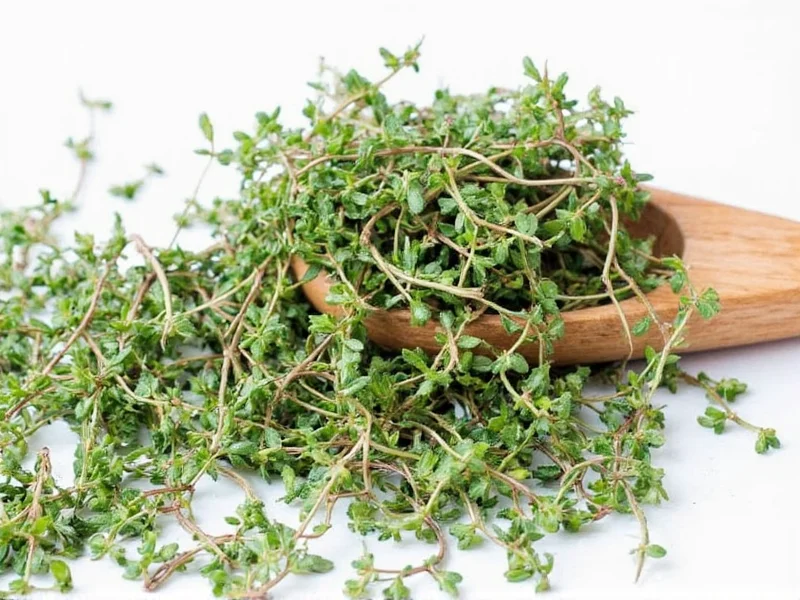Understanding fresh thyme conversion to dried is essential for consistent cooking results. When recipes call for one form but you only have the other, knowing the proper substitution ratio prevents flavor imbalances in your dishes. The 3:1 conversion ratio exists because drying thyme removes moisture while concentrating its essential oils and flavor compounds.
Why the 3:1 Fresh to Dried Thyme Ratio Matters
Thyme loses approximately 70-80% of its weight during the drying process. This significant moisture reduction means dried thyme packs more flavor per volume than its fresh counterpart. Using equal amounts would result in under-seasoned dishes with fresh thyme or overpowering flavors with dried thyme.
The conversion ratio applies to both common thyme varieties (Thymus vulgaris) and lemon thyme. While some chefs suggest slight adjustments based on specific recipes, the 3:1 ratio provides reliable starting point for most culinary applications.
Fresh Thyme to Dried Conversion Chart
| Fresh Thyme | Dried Thyme Equivalent |
|---|---|
| 1 teaspoon | 1/4 teaspoon |
| 1 tablespoon | 1 teaspoon |
| 1/4 cup | 1 tablespoon |
| 1/2 cup | 2 tablespoons |
| 1 cup | 1/3 cup |
Practical Substitution Tips for Cooking
When converting fresh thyme to dried in recipes, consider these professional techniques:
- Add dried thyme earlier: Dried herbs need time to rehydrate and release flavors. Add them at the beginning of cooking rather than at the end like fresh thyme.
- Crush dried thyme: Rub dried thyme between your fingers before adding to release more flavor compounds.
- Adjust for dish type: For soups and stews with long cooking times, use slightly less dried thyme (try 7/8 teaspoon instead of 1 teaspoon per tablespoon of fresh).
- Consider freshness: Older dried thyme loses potency. If your dried thyme is over a year old, increase the amount by 25%.
Flavor Differences Between Fresh and Dried Thyme
Fresh thyme offers brighter, more delicate notes with subtle grassy undertones, while dried thyme develops deeper, more concentrated earthy flavors. The drying process transforms some volatile compounds, creating slightly different flavor profiles.
Chefs often prefer fresh thyme for:
- Raw applications like salads and garnishes
- Short-cooking dishes like omelets and sautés
- Fresh sauces and vinaigrettes
Dried thyme works better for:
- Long-simmering dishes like stews and braises
- Dry rubs and spice blends
- Baked goods and breads
Proper Storage for Maximum Flavor Retention
To maintain optimal flavor in both forms:
- Fresh thyme: Store stems upright in a glass with 1 inch of water, covered loosely with a plastic bag in the refrigerator. Use within 10-14 days.
- Dried thyme: Keep in an airtight container away from light and heat. Properly stored, it retains good flavor for 1-2 years (though peak quality is within 6 months).
Common Conversion Mistakes to Avoid
Many home cooks make these errors when substituting thyme forms:
- Equal substitution: Using 1:1 ratio instead of 3:1 creates bland or overpowering dishes
- Ignoring recipe timing: Adding dried thyme at the end of cooking when it needs time to rehydrate
- Not adjusting for age: Using old dried herbs without increasing quantity
- Overpacking measuring spoons: Dried thyme should be lightly spooned and leveled, not packed
When to Make Small Ratio Adjustments
While the 3:1 fresh thyme to dried conversion ratio works for most situations, consider these exceptions:
- Delicate dishes: For subtle-flavored recipes like fish or light sauces, use a 2.5:1 ratio to prevent overwhelming the dish
- Strong-flavored dishes: In robust recipes like game meats or hearty stews, a 3.5:1 ratio might work better
- Homemade dried thyme: If you've air-dried thyme yourself (not oven-dried), use a 2.5:1 ratio as it retains more moisture
- International recipes: European recipes often use more herbs than American ones—adjust accordingly











 浙公网安备
33010002000092号
浙公网安备
33010002000092号 浙B2-20120091-4
浙B2-20120091-4